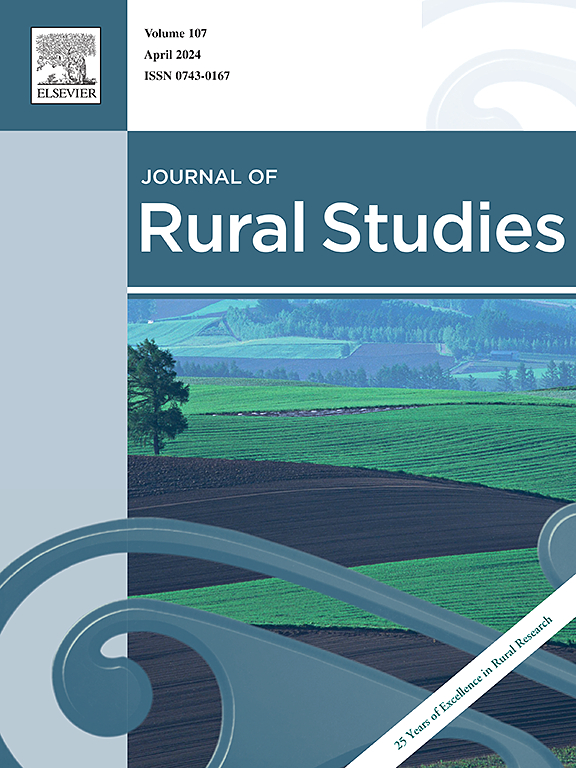Gender as an entangled force: Gendered mining entanglements, labor organization and leadership structure in artisanal and small-scale mining
IF 5.1
1区 社会学
Q1 GEOGRAPHY
引用次数: 0
Abstract
Place-making practices and gender in artisanal and small-scale mining (ASM) have been documented in the literature. Yet, studies have not critically explored the interactions of spatial, material and sociocultural forces in the coproduction of gendered mining practices and leadership structure in ASM spaces. Drawing on a qualitative, ethnographic study on women in ASM in Ghana, we apply the concept of mining entanglements to examine the sociometerial and space-gender interactions in ASM settings to identify the gendered mining entanglements that cocreate gendered mining work patterns, leadership structure, and economic relations. Findings showed that ASM space – in terms of extraction (e.g., underground extraction, and surface extraction) and processing locations – were socially constructed for gender roles. Such spatial forces of ASM combined with entangled material forces – human bodies, mining tools/equipment and mining practices – and sociocultural forces (i.e. sociocultural discourse of women’s menstrual bodies) in the coproduction of gendered patterns of mining works, economic relations, and leadership structure. The spatial, material and sociocultural forces were used in the framing and theorization of gender as an entangled force, where each force can distinctively explain gender and how they dictate the economic roles of women and men. Findings further showed that the mining entangled forces intersected with various factors related to women – such as age, working experience, social connections, sexual relations, educational status and ethnicity – to cocreate micropolitics of everyday realities of gendered labor dynamics and economic power relations influencing women’s eligibility or qualification for site committee membership or leadership positions in ASM sites. Based on the gendered socioeconomic and political inequality, formalization efforts and interventions that seek to promote women’s economic empowerment and address barriers to female ASM participation should tackle the gendered mining entanglements impacting women's socioeconomic and health outcomes.

作为纠缠力的性别:手工和小规模采矿中的性别采矿纠缠、劳工组织和领导结构
文献记载了手工和小规模采矿(ASM)中的场所制造实践和性别。然而,研究还没有批判性地探讨空间、物质和社会文化力量在ASM空间中性别采矿实践和领导结构的共同生产中的相互作用。通过对加纳ASM女性的定性、人种学研究,我们应用采矿纠缠的概念来研究ASM环境中的社会物质和空间性别相互作用,以确定共同创造性别采矿工作模式、领导结构和经济关系的性别采矿纠缠。研究结果表明,在提取(如地下提取和地表提取)和处理地点方面,ASM空间是根据性别角色社会建构的。ASM的这种空间力量与相互纠缠的物质力量(人体、采矿工具/设备和采矿实践)和社会文化力量(即女性经期身体的社会文化话语)结合在一起,共同生产了采矿工程的性别模式、经济关系和领导结构。空间、物质和社会文化力量被用于性别的框架和理论化,作为一种纠缠的力量,其中每一种力量都可以独特地解释性别,以及它们如何决定女性和男性的经济角色。研究结果进一步表明,挖掘纠缠的力量与与妇女有关的各种因素——如年龄、工作经验、社会关系、性关系、教育状况和种族——交织在一起,共同创造了性别劳动动态和经济权力关系等日常现实的微观政治,这些现实影响着妇女在ASM现场委员会成员或领导职位的资格或资格。基于性别的社会经济和政治不平等,旨在促进妇女经济赋权和消除阻碍妇女参与ASM的障碍的正规化努力和干预措施应解决影响妇女社会经济和健康结果的性别采矿纠缠问题。
本文章由计算机程序翻译,如有差异,请以英文原文为准。
求助全文
约1分钟内获得全文
求助全文
来源期刊

Journal of Rural Studies
Multiple-
CiteScore
9.80
自引率
9.80%
发文量
286
期刊介绍:
The Journal of Rural Studies publishes research articles relating to such rural issues as society, demography, housing, employment, transport, services, land-use, recreation, agriculture and conservation. The focus is on those areas encompassing extensive land-use, with small-scale and diffuse settlement patterns and communities linked into the surrounding landscape and milieux. Particular emphasis will be given to aspects of planning policy and management. The journal is international and interdisciplinary in scope and content.
 求助内容:
求助内容: 应助结果提醒方式:
应助结果提醒方式:


